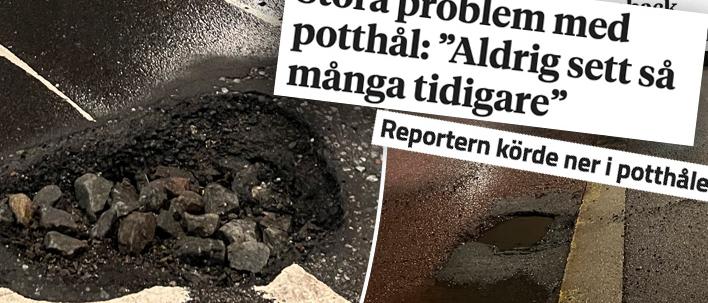unsaveSave
expand-left
full screen One reason for the unusually high number of pot holes this year is believed to be the early and cold winter. Photo: Niklas Eriksson
The hidden dangers on the road have become a national talking point.
The potholes create an unusual amount of problems.
– There are about 50 new notifications that come in every day, says Mikael Arvidsson, unit manager for street maintenance in Eskilstuna to SVT.
There are no posts yet.
The holes hide themselves. Often they are also filled with water after the roads have cracked.
This year they also seem to be unusually numerous. The early and very cold winter is seen as an explanation.
– We have had an early winter and a cold winter. This means that we had weather that is otherwise mostly seen in Central Sweden and that has contributed to the many injuries, says Pajtim Sulejmani, who works for the city of Malmö to SVT News Skåne.
The large temperature changes are also believed to have contributed to the progress of the potholes. Because when water penetrates into small cavities, the freezing temperatures come and the ice expands, then the road cracks even more.
expand-left
full screen Pothole in Stockholm. Photo: Niklas Eriksson
In Eskilstuna, the municipality receives about 50 notifications of new holes every day.
– What is unusual now is that we have had very cold and very hot weather in a very short time. Normally, when the frost leaves the ground, it is about 6–8 weeks. Now we had a temperature change of 24-30 degrees within a day, says Mikael Arvidsson to SVT Nyheter Sörmland.
According to the industry organization Transport företagen 34 percent of the almost 100,000 kilometers of state roads are in very bad or bad condition. According to their analysis, it would cost SEK 16.5 billion to fix the worst eleven percent.
– There is no quick-fix in this matter, you have to constantly entertain. Potholes may start as cracks that then get bigger and bigger, says Tina Thorsell, social policy manager at Transportföretagen.
Heavy traffic has also increased on Swedish roads in connection with Sweden investing in increasingly climate-smart transport targets.
– Emissions decrease but traffic increases and we get heavier transports. It is clear that it wears on the roads and then maintenance becomes even more important, says Thorsell.
She believes that the reason for the bad roads is a political issue that has long been under-prioritized and under-funded.
– It might have been more interesting and fancy for politicians to inaugurate hospitals or bridges, but then the ongoing road maintenance has had to stand aside, says Thorsell.
expand-left
full screen Photo: Andreas Hillergren
Damage to the car can provide compensation
Anyone who is unlucky enough to end up in a pothole risks wrecking the car. Partly through vehicle insurance and own insurance on the car. But there is also the possibility that the municipality will provide financial compensation.
– On the occasions that the municipality has not remedied, a damage known to us, within a reasonable and reasonable time there is the possibility to make demands on the municipality, says Mikael Arvidsson to SVT.
All over the country’s municipalities are now working hard to combat potholes.
In Malmö, work is focused on repairing the city’s roads. But it is also a battle against the clock.
– If it rains and then freezes, the holes and cracks that exist and have not been repaired expand, says Pajtim Sulejmani.
The Swedish Transport Administration, which has the ultimate responsibility for the country’s roads, believes that it is a “waste of both time and money” to go out and lay new asphalt if it is below freezing.
– It is not possible to pave when the temperatures are so low, said the Swedish Transport Agency’s press manager Bengt Olsson to TT at the beginning of the year.
